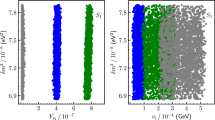Abstract
We show that a right-handed stop in the 200–400 GeV mass range, together with a nearly degenerate neutralino and, possibly, a gluino below 1.5 TeV, follows from reasonable assumptions, is consistent with present data, and offers interesting discovery prospects at the LHC. Triggering on an extra jet produced in association with stops allows the experimental search for stops even when their mass difference with neutralinos is very small and the decay products are too soft for direct observation. Using a razor analysis, we are able to set stop bounds that are stronger than those published by ATLAS and CMS.










Similar content being viewed by others
Notes
This configuration is known as the “maximal mixing” case, although it does not necessarily imply a large mixing between the two stop mass eigenstates, as discussed in Sect. 2.
References
ATLAS Collaboration, Phys. Lett. B 716, 1 (2012). arXiv:1207.7214
CMS Collaboration, Phys. Lett. B 716, 30 (2012). arXiv:1207.7235
A. Strumia, J. High Energy Phys. 1104, 073 (2011). arXiv:1101.2195, see for example
R. Barbieri, D. Pappadopulo, J. High Energy Phys. 0910, 061 (2009). arXiv:0906.4546
M. Papucci, J.T. Ruderman, A. Weiler, J. High Energy Phys. 1209, 035 (2012). arXiv:1110.6926
C. Brust, A. Katz, S. Lawrence, R. Sundrum, J. High Energy Phys. 1203, 103 (2012). arXiv:1110.6670
Z. Han, A. Katz, D. Krohn, M. Reece, J. High Energy Phys. 1208, 083 (2012). arXiv:1205.5808
J.R. Espinosa, C. Grojean, V. Sanz, M. Trott, arXiv:1207.7355 [hep-ph]
M. Carena, G. Nardini, M. Quiros, C.E.M. Wagner, J. High Energy Phys. 0810, 062 (2008). arXiv:0806.4297
C.-L. Chou, M.E. Peskin, Phys. Rev. D 61, 055004 (2000). hep-ph/9909536
G. Hiller, J.S. Kim, H. Sedello, Phys. Rev. D 80, 115016 (2009). arXiv:0910.2124 [hep-ph]
D.S.M. Alves, M.R. Buckley, P.J. Fox, J.D. Lykken, C.-T. Yu, arXiv:1205.5805
C. Kilic, B. Tweedie, arXiv:1211.6106
The result is obtained updating the fit of P.P. Giardino, K. Kannike, M. Raidal, A. Strumia, arXiv:1207.1347
M. Ciuchini, G. Degrassi, P. Gambino, G.F. Giudice, Nucl. Phys. B 534, 3 (1998). hep-ph/9806308
E. Gabrielli, G.F. Giudice, Nucl. Phys. B 433, 3 (1995) [Erratum—ibid. B 507, 549 (1997)]. hep-lat/9407029
M. Misiak, H.M. Asatrian, K. Bieri, M. Czakon, A. Czarnecki, T. Ewerth, A. Ferroglia, P. Gambino et al., Phys. Rev. Lett. 98, 022002 (2007). hep-ph/0609232
Heavy Flavor Averaging Group Collaboration, arXiv:1207.1158
BABAR Collaboration, arXiv:1207.5772
A.J. Bevan et al., PoS HQL 2010 (2011) 019. http://utfit.org/UTfit
M. Farina, M. Kadastik, D. Pappadopulo, J. Pata, M. Raidal, A. Strumia, Nucl. Phys. B 853, 607 (2011). arXiv:1104.3572
M. Kadastik, K. Kannike, A. Racioppi, M. Raidal, J. High Energy Phys. 1205, 061 (2012). arXiv:1112.3647
G. Hiller, Y. Nir, J. High Energy Phys. 0803, 046 (2008). arXiv:0802.0916
CMS Collaboration, J. High Energy Phys. 1209, 094 (2012). arXiv:1206.5663
ATLAS Collaboration, arXiv:1210.4491
ATLAS Collaboration, Phys. Lett. B 710, 67 (2012). arXiv:1109.6572
CMS Collaboration, arXiv:1210.8115
C. Rogan, arXiv:1006.2727
CMS Collaboration, arXiv:1212.6961
T. Sjostrand, S. Mrenna, P.Z. Skands, Comput. Phys. Commun. 178, 852 (2008). arXiv:0710.3820
M. Cacciari, G.P. Salam, G. Soyez, Eur. Phys. J. C 72, 1896 (2012). arXiv:1111.6097
M. Cacciari, G.P. Salam, Phys. Lett. B 641, 57 (2006). hep-ph/0512210
M. Cacciari, G.P. Salam, G. Soyez, J. High Energy Phys. 0804, 063 (2008). arXiv:0802.1189
The details on how to implement the CMS razor analyses outside the CMS analysis framework are given in https://twiki.cern.ch/twiki/bin/view/CMSPublic/RazorLikelihoodHowTo
CMS Collaboration, J. High Energy Phys. 1208, 110 (2012). arXiv:1205.3933
P.J. Fox, R. Harnik, R. Primulando, C.-T. Yu, Phys. Rev. D 86, 015010 (2012). arXiv:1203.1662
M. Kramer, A. Kulesza, R. van der Leeuw, M. Mangano, S. Padhi, T. Plehn, X. Portell, arXiv:1206.2892
Z.-H. Yu, X.J. Bi, Q.-S. Yan, arXiv:1211.2997
K. Kriza, A. Kumar, D.E. Morissey, arXiv:1212.4856
CMS Collaboration, CMS-PAS-SUS-11-024
Acknowledgements
A.D. was partly supported by the National Science Foundation under grants PHY-0905383-ARRA and PHY-1215979. A.S. was supported by the ESF grant MTT8 and by SF0690030s09 project.
Author information
Authors and Affiliations
Corresponding author
Appendix
Appendix
In this appendix we derive the four-body stop decay width given in (24). In the limit of small mass difference (ΔM≪M W ,m t ), the amplitude for pure right-handed stop decay \(\tilde{t}_{R} \to N b e^{+}\nu\) is

where P i are the quadri-momenta of the particles involved. The decay width is given by

The 4-body phase space integral dϕ (4) can be analytically performed at leading order in \(\Delta M =m_{\tilde{t}}- M_{\mathrm{DM}}\). Indeed, by writing the decay as \(\tilde{t}\to XY\to(Ne)(b\nu)\), the amplitude for each sub-decay is separately Lorentz invariant. Thus, using


we get


where we have kept only the leading order in ΔM. From these expressions we obtain (24).
Rights and permissions
About this article
Cite this article
Delgado, A., Giudice, G.F., Isidori, G. et al. The light stop window. Eur. Phys. J. C 73, 2370 (2013). https://doi.org/10.1140/epjc/s10052-013-2370-5
Received:
Revised:
Published:
DOI: https://doi.org/10.1140/epjc/s10052-013-2370-5



